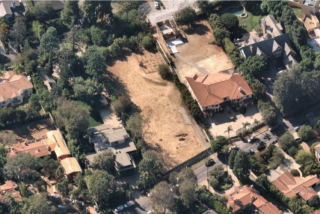Tiny Lots Create Big Land-Use Problems for Lancaster Officials
It began as a gimmick to sell newspapers. It has become one of Lancaster’s biggest land-use headaches.
In 1910, the Los Angeles Evening Herald gave away lots measuring 25 feet by 100 feet in Lancaster, a bonus for readers who took a yearlong subscription to the now-defunct paper. About 1,000 of the tiny parcels were packed into 20 blocks.
The area, known as the Herald Tract, was long considered the boondocks. A few shotgun homes were squeezed onto lots that could not be built on under current city codes. The tract now is mostly a mix of vacant land and auto-repair shops. And it sits at the edge of Lancaster’s central business district, a roadblock to development.
For two decades, the Lancaster Redevelopment Agency has been buying up contiguous Herald Tract lots, then selling consolidated parcels to businesses looking for cheap land.
Although the strategy has had some success, it has in many cases proved to be a nightmare, said Stafford Parker, the redevelopment agency’s director.
Officials will assemble a number of lots only to encounter a deal-killing holdout in the middle of a block. The agency has also found its buying sprees create a demand that pushes up prices.
And through the years, owners of these dusty slivers have scattered like scraps of newsprint in the desert wind.
“There are a bunch [of parcels] where we can’t even find the property owners,” City Manager James Gilley said.
Promotional Southern California land giveaways were common in the heady days of the early 1900s, and the tiny lots left behind still bedevil government planners from Ventura to Orange County.
Vestiges of Old Contests Dot County Landscape
Los Angeles County is dotted with vestiges of old contests, many of them in hilly areas such as El Sereno and Topanga Canyon, where property lines were drawn without regard for topography or utility access, county planner Paul McCarthy said.
In the Chatsworth hills above the Ronald Reagan Freeway, about 500 lots were given away, their titles apparently stuffed into cereal boxes as prizes, McCarthy said.
One by one, the county acquired the parcels as a result of tax delinquencies, and a developer is now planning a subdivision on the property, which is just north of Mayan Drive.
Like the Herald Tract, the Chatsworth project was tormented by a few holdouts, McCarthy said.
“They have [parcel owners] who were declared incompetent, or they’re in a rest home,” he said. “We got one guy who was wanted for murder, and we can’t find him.”
The Herald Tract is a more pressing challenge for Lancaster because the land is in the middle of the city, not far from Lancaster Boulevard and its Aerospace Walk of Honor. The property extends from Avenue J north to Milling Street, and Division Street west to the railroad tracks.
Although the redevelopment agency doesn’t have the money to fix the problem overnight, it has made the tract a top priority, said Kurt Gunzel, the agency’s point man for the project.
Officials could not say precisely how much they’ve spent during the last 20 years on acquiring the lots, but city documents indicate the amount is between $1.1 million and $2.2 million. The money has paid for about 200 lots, at $5,000 to $11,000 each. A roughly equal number of privately owned, undeveloped parcels remain.
“This is a project we’re never going to give up on,” Parker said. “But it’ll be a long time in finishing.”
Some Lots Bundled to Meet Needs
In the late 1980s, enough lots were cobbled together to build a critically needed flood basin. Others have been bundled to create space for a city homeless shelter and an expanding auto-body shop.
Next month, Gilley said, the City Council will consider selling a Herald Tract acre to an ice company.
“There will be more,” Gilley said. “We just resurfaced the existing streets in there. Now it looks better, and people will have more of an interest in it.”
While many of the auto shops are flourishing in the Herald Tract, the vacant parcels are favorite spots for dumping and vagrant camps. The city has responded aggressively, with regular cleanups and a crackdown on homelessness.
“The city has been very instrumental in keeping the undesirables out,” said Linda Beggs, owner of the tract’s Desert Lock Co. “A little at a time, things have been upgrading.”
Most of the smallest homes have been razed.
“They were sort of like miniature cabins--but they weren’t quaint,” said Bill Thomas, a Lancaster librarian and local historian.
The houses that survived are mostly near Division Street. Michael Logan, 36, has lived in a narrow cream-colored house on Pillsbury Street for about four years. With few neighbors, but a lot of passing rowdies, Logan said life in the tract is alternately quiet and boisterous.
“When I first moved here, my friends and I would pull up lawn chairs on the weekends and just watch the Jerry Springer show go by,” he said, nodding toward a nearby bar. “But other than that, it’s real quiet.”
Frank Stubbings, 84, lives in a house that occupies a number of consolidated Herald Tract lots. When he moved to town in the 1940s, he said, there were few of the original newspaper subscribers actually living in the neighborhood.
“It was a gimmick, but most of the people who got the lots . . . never moved out here,” he said. “They just thought, ‘I’m going to get the paper and land in Lancaster--well, good deal.’ ”
More to Read
Sign up for Essential California
The most important California stories and recommendations in your inbox every morning.
You may occasionally receive promotional content from the Los Angeles Times.









